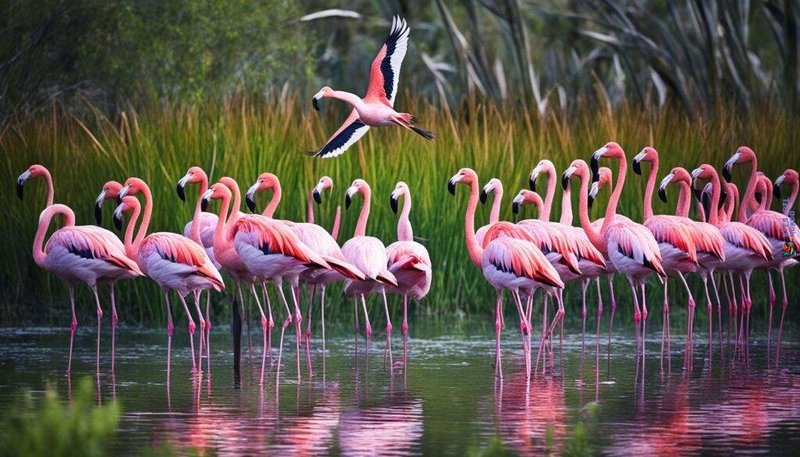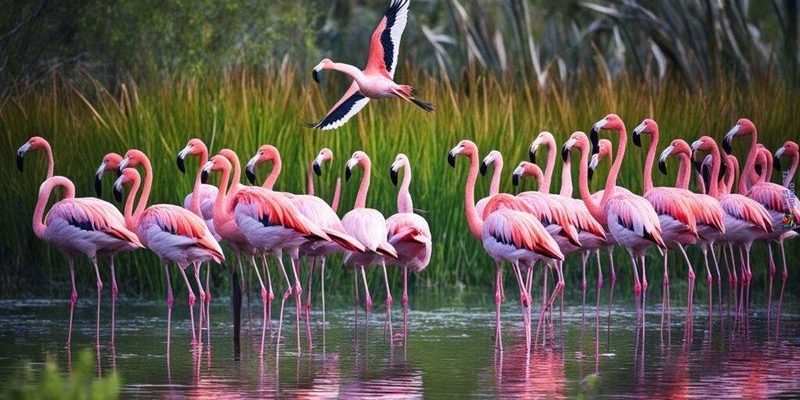
You might wonder why these bright birds need special attention. The truth is, flamingos are essential players in their ecosystems. They help maintain the balance in wetlands and lagoons, filtering water as they feed and supporting other wildlife. Unfortunately, as human activities continue to threaten their habitats—like urban development, pollution, and climate change—conservationists are stepping up. These dedicated individuals and organizations have been working to ensure that flamingos not only survive but thrive in their natural environments.
The Importance of Flamingo Conservation
Here’s the thing: flamingos aren’t just pretty faces in the animal kingdom. They play a vital role in their ecosystems. By sifting through the mud and filtering out tiny organisms for food, flamingos help keep waterways clean and healthy. If their populations decline, it can lead to an imbalance, affecting other species that rely on those ecosystems.
Furthermore, flamingos are indicators of environmental health. Healthy flamingo populations often signal a balanced ecosystem, while declines can hint at larger environmental problems. This makes protecting them not only about preserving their beauty but also about safeguarding quality of life for countless other species, including humans.
Conservation efforts aimed at protecting flamingos aren’t just about saving a single species. They’re about maintaining biodiversity, which is essential for a functioning planet. When we lose one species, it can lead to a ripple effect, causing declines in others. So, protecting flamingos helps in preserving the broader ecosystem we all depend on.
Current Threats to Flamingos
Flamingos face several threats that make their survival increasingly difficult. One major issue is habitat loss. As cities expand, wetlands where flamingos nest and feed are often drained or polluted. This not only reduces their habitat but also compromises the delicate balance of the ecosystem.
Another significant factor is climate change. Rising temperatures can alter water salinity levels in lagoons and wetlands, making these areas less suitable for flamingo nesting. Additionally, extreme weather events can destroy nests and reduce food availability. You might think of it like a series of unfortunate circumstances piling up on these beautiful birds.
Finally, there is human interference, often through fishing and agriculture, that can disrupt flamingo feeding grounds. Chemical run-off from farms can pollute their habitats, making it tough for flamingos to find the clean water they need. These combined factors create a perfect storm, pushing flamingos to the brink.
Key Conservation Strategies
To combat these threats, various conservation strategies are in place. One essential approach is habitat restoration. Organizations are working hard to restore wetlands and lagoons that have been lost. This often involves cleaning up polluted areas and reestablishing natural water flow. By bringing these environments back to life, they can support flamingo populations once again.
Another vital strategy is public education and awareness. By teaching communities about the importance of flamingos and their ecosystems, conservationists are fostering a sense of responsibility. Imagine a school organizing field trips to see these amazing birds in their natural habitats. This not only raises awareness but also turns people into advocates for conservation efforts.
Moreover, careful monitoring is essential. Organizations use tracking technology to follow flamingo populations, studying their movements and behaviors. This data helps conservationists understand what flamingos need to thrive, leading to more effective conservation strategies.
Protected Areas and Reserves
One of the most effective ways to protect flamingos is through the establishment of protected areas and reserves. These designated spaces are crucial for providing safe nesting and feeding grounds for the birds. Nations around the world have set up wildlife reserves specifically aimed at protecting flamingo habitats.
For example, the Camargue region in France is famous for its flamingo population. The establishment of the Camargue Regional Nature Park has provided a sanctuary for these birds, ensuring that they have a safe environment to thrive. This sanctuary not only protects flamingos but also benefits other wildlife in the area, creating a balanced ecosystem.
Additionally, международные программы (international programs) often promote cross-border cooperation to protect migratory flamingo populations. Since some species migrate long distances, collaboration between countries is necessary to ensure their protection at every stop along their journey.
The Role of Local Communities in Conservation
Local communities play a vital role in the success of flamingo conservation. When people living near flamingo habitats understand their value, they’re more likely to protect them. Many communities have become involved in conservation efforts, often benefiting from sustainable tourism and eco-friendly practices.
For instance, in some regions, guided eco-tours are conducted, allowing people to see flamingos up close while learning about their importance. This not only raises funds to support conservation but also instills pride in local cultures and environments. It’s an empowering example of how conservation can go hand-in-hand with community development.
Moreover, local initiatives can also involve monitoring and protecting nesting sites. When community members see flamingos as part of their identity, they become motivated to safeguard their habitats. It’s like building a relationship between people and the environment, where both thrive together.
Future Directions and Challenges
Looking ahead, conservation efforts aimed at protecting flamingos face both opportunities and challenges. On one hand, there’s growing global awareness of environmental issues. More people are recognizing the importance of biodiversity, and that’s a good sign for flamingo conservation.
Innovative conservation technologies, such as drones for habitat monitoring and environmental sensors, are becoming more accessible. These tools can provide crucial data to help conserve flamingos and other wildlife more efficiently. It’s like having a high-tech toolkit for nature enthusiasts!
However, challenges remain. Political and economic pressures can sometimes overshadow conservation efforts. Climate change continues to pose a significant threat, and the urgency to act is greater than ever. If we want to ensure flamingos continue to grace our planet, we need to stay committed and proactive.
Conservation efforts aimed at protecting the flamingo are critical not just for the birds themselves but for the health of our ecosystems as a whole. As we’ve explored, these efforts encompass habitat restoration, community engagement, and international collaboration, all of which contribute to a brighter future for flamingos.
It’s fascinating to see how interconnected life is on our planet. Protecting flamingos means preserving beautiful landscapes and thriving ecosystems that benefit countless other species. So, the next time you see a flamingo, remember all the hard work behind the scenes to keep these stunning birds soaring. Together, we can continue to appreciate their beauty while actively taking steps to ensure they remain a part of our world for years to come.

